2007 HONDA CIVIC COUPE cooling
[x] Cancel search: coolingPage 233 of 311
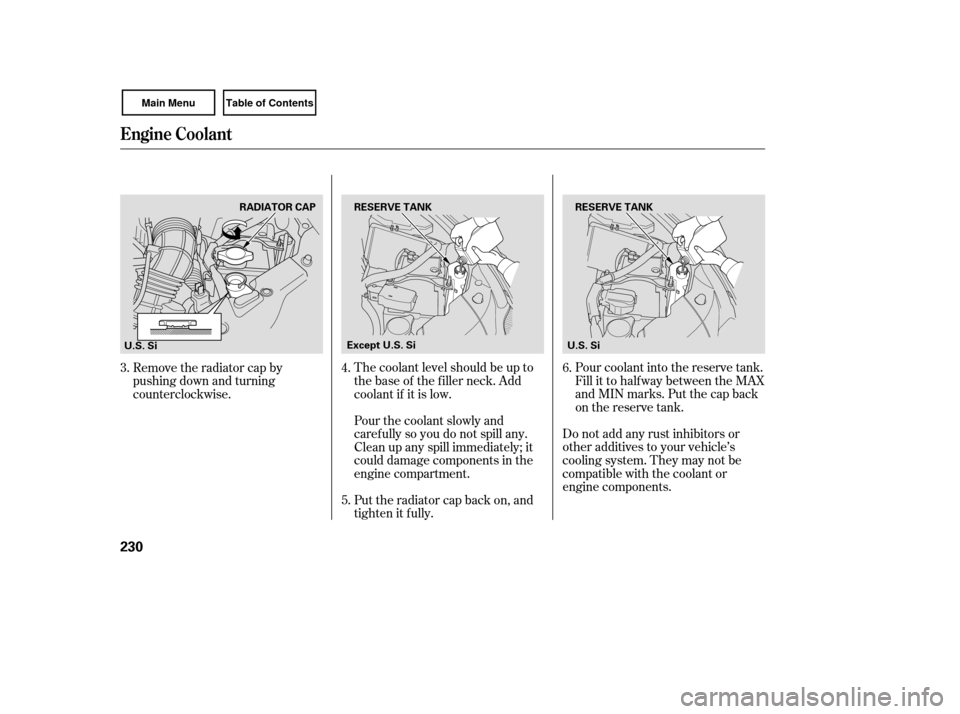
Pour coolant into the reserve tank.
Fill it to half way between the MAX
and MIN marks. Put the cap back
on the reserve tank.
Do not add any rust inhibitors or
other additives to your vehicle’s
cooling system. They may not be
compatible with the coolant or
engine components.
The coolant level should be up to
the base of the f iller neck. Add
coolant if it is low.
Pourthecoolantslowlyand
caref ully so you do not spill any.
Clean up any spill immediately; it
could damage components in the
engine compartment.
Put the radiator cap back on, and
tighten it fully.
Remove the radiator cap by
pushing down and turning
counterclockwise.
3. 4.
5.6.
Engine Coolant
230
RADIATOR CAP
RESERVE TANK
RESERVE TANK
U.S. Si Except U.S. Si
U.S. Si
Page 245 of 311
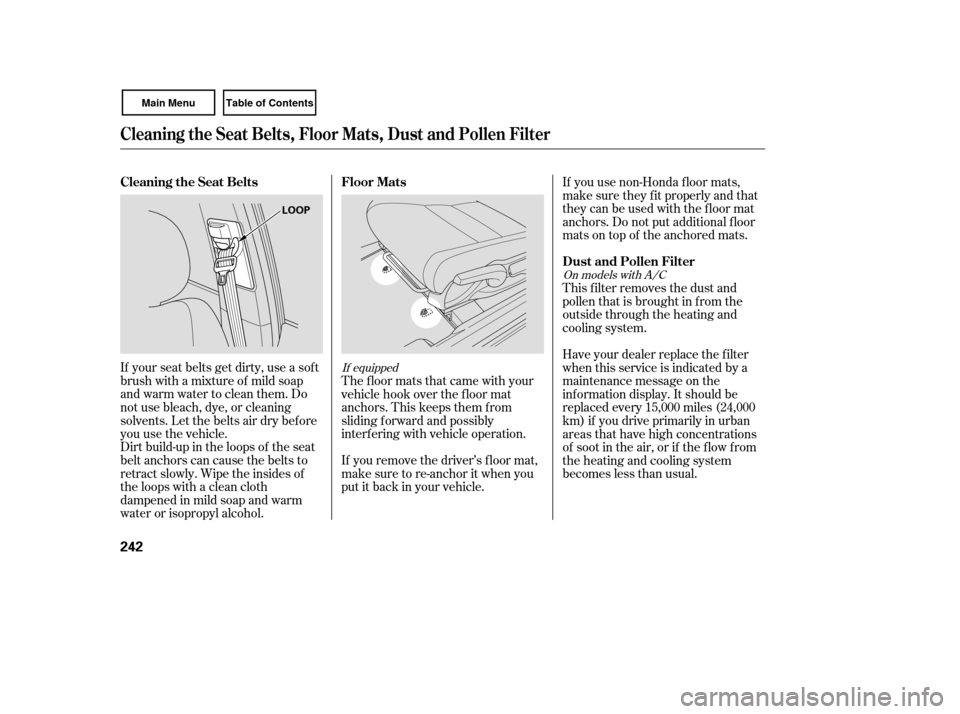
Dirt build-up in the loops of the seat
belt anchors can cause the belts to
retract slowly. Wipe the insides of
the loops with a clean cloth
dampened in mild soap and warm
water or isopropyl alcohol.This f ilter removes the dust and
pollenthatisbroughtinfromthe
outside through the heating and
cooling system.
If your seat belts get dirty, use a sof t
brush with a mixture of mild soap
and warm water to clean them. Do
not use bleach, dye, or cleaning
solvents. Let the belts air dry bef ore
you use the vehicle. The floor mats that came with your
vehicle hook over the f loor mat
anchors. This keeps them f rom
sliding f orward and possibly
interf ering with vehicle operation.
If you remove the driver’s f loor mat,
make sure to re-anchor it when you
putitbackinyourvehicle.If you use non-Honda f loor mats,
make sure they f it properly and that
theycanbeusedwiththefloormat
anchors. Do not put additional f loor
mats on top of the anchored mats.
Have your dealer replace the filter
when this service is indicated by a
maintenance message on the
inf ormation display. It should be
replaced every 15,000 miles (24,000
km) if you drive primarily in urban
areas that have high concentrations
of soot in the air, or if the f low f rom
the heating and cooling system
becomeslessthanusual.
If equipped
On models with A/C
Floor Mats
Dust and Pollen Filter
Cleaning the Seat Belts
Cleaning the Seat Belts, Floor Mats, Dust and Pollen Filter
242
LOOP
Page 257 of 311
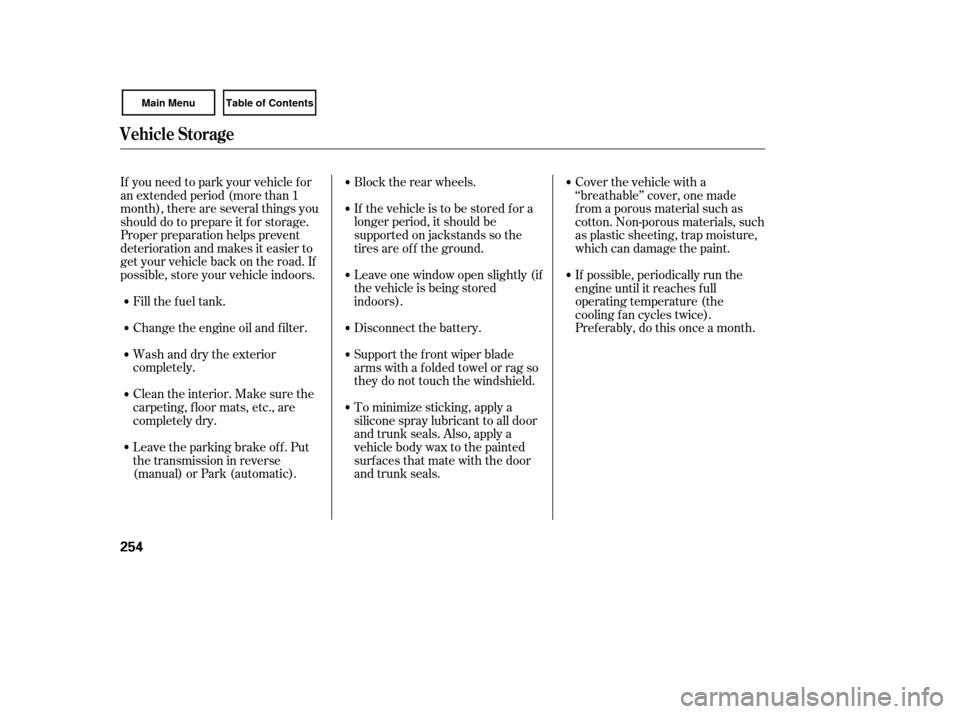
Fill the f uel tank.
Change the engine oil and f ilter.Block the rear wheels.
If the vehicle is to be stored f or a
longer period, it should be
supported on jackstands so the
tires are of f the ground.
Wash and dry the exterior
completely.
Cleantheinterior.Makesurethe
carpeting, floor mats, etc., are
completely dry.
If you need to park your vehicle f or
an extended period (more than 1
month), there are several things you
should do to prepare it f or storage.
Proper preparation helps prevent
deterioration and makes it easier to
get your vehicle back on the road. If
possible, store your vehicle indoors. Leave one window open slightly (if
the vehicle is being stored
indoors).Cover the vehicle with a
‘‘breathable’’ cover, one made
f rom a porous material such as
cotton. Non-porous materials, such
as plastic sheeting, trap moisture,
which can damage the paint.
To minimize sticking, apply a
silicone spray lubricant to all door
and trunk seals. Also, apply a
vehiclebodywaxtothepainted
surfaces that mate with the door
and trunk seals. Support the f ront wiper blade
arms with a f olded towel or rag so
they do not touch the windshield. Disconnect the battery. If possible, periodically run the
engine until it reaches f ull
operating temperature (the
cooling f an cycles twice).
Pref erably, do this once a month.
Leave the parking brake off. Put
the transmission in reverse
(manual) or Park (automatic).
Vehicle Storage
254
Page 269 of 311
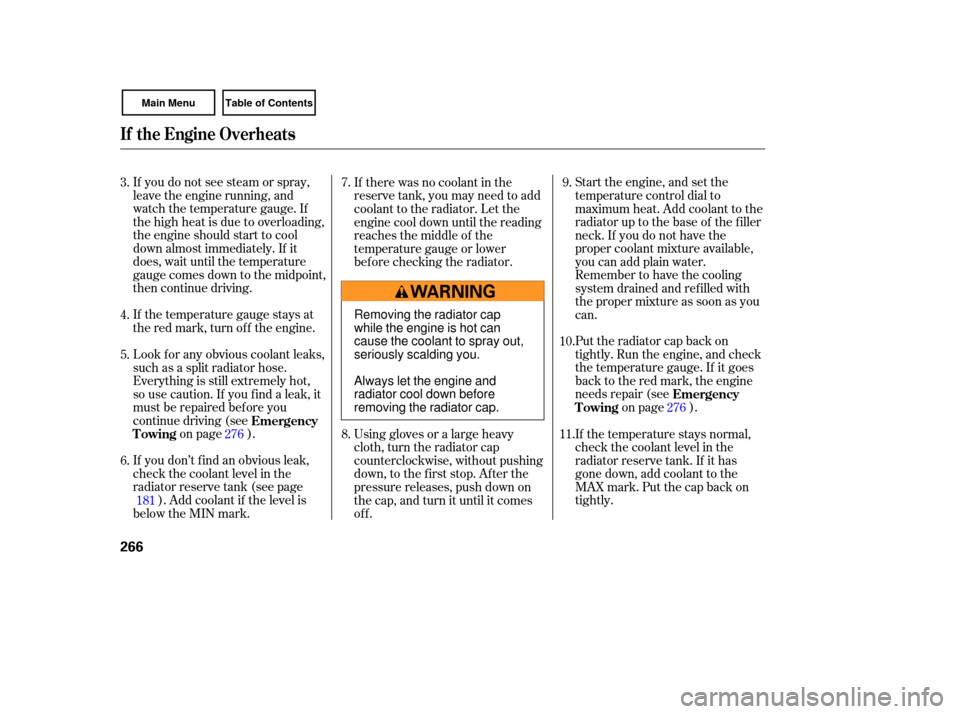
Put the radiator cap back on
tightl y. Run the engine, and check
the temperatu re gauge. If it goes
back to the red mark, the engine
needs repair (see
on page ).
If
you do not see steam or spray,
leave the engine running, and
watch the temperature gauge. If
the high heat is due to overloading,
the engine should start to cool
down almost immediately. If it
does, wait until the temperatu re
gauge comes down to the midpoint,
th en continue driving.
If the temperatu re gauge stays at
the red mark, turn off the engine.
Look for any obvious coolant leaks,
such as a split radiator hose.
Everything is still extremely hot,
so use caution. If you find a leak, it
must be repaired before you
continue driving (see
on page ).
If you don’t find an obvious leak,
check the coolant level in the
radiator reserve tank (see page
). Add coolant if the level is
below the MIN mark. Start the engine, and set the
temperature control dial to
maximum heat. Add coolant to the
radiator up to the base of the f iller
neck. If you do not have the
proper coolant mixture available,
you can add plain water.
Remember to have the cooling
system drained and ref illed with
the proper mixture as soon as you
can.
If the temperature stays normal,
check the coolant level in the
radiator reserve tank. If it has
gone down, add coolant to the
MAX mark. Put the cap back on
tightly.
Using gloves or a large heavy
cloth, turn the radiator cap
counterclockwise, without pushing
down, to the f irst stop. Af ter the
pressure releases, push down on
the cap, and turn it until it comes
off. If there was no coolant in the
reserve tank, you may need to add
coolant to the radiator. Let the
engine cool down until the reading
reaches the middle of the
temperature gauge or lower
bef ore checking the radiator.
7.
8. 9.
3.
4.
5.
6. 10.
11.
276
181 276
Emergency
Towing
Emergency
Towing
If theEngineOverheats
266
Removing the radiator cap
while the engine is hot can
cause the coolant to spray out,
seriously scalding you.
Always let the engine and
radiator cool down before
removing the radiator cap.
Page 305 of 311
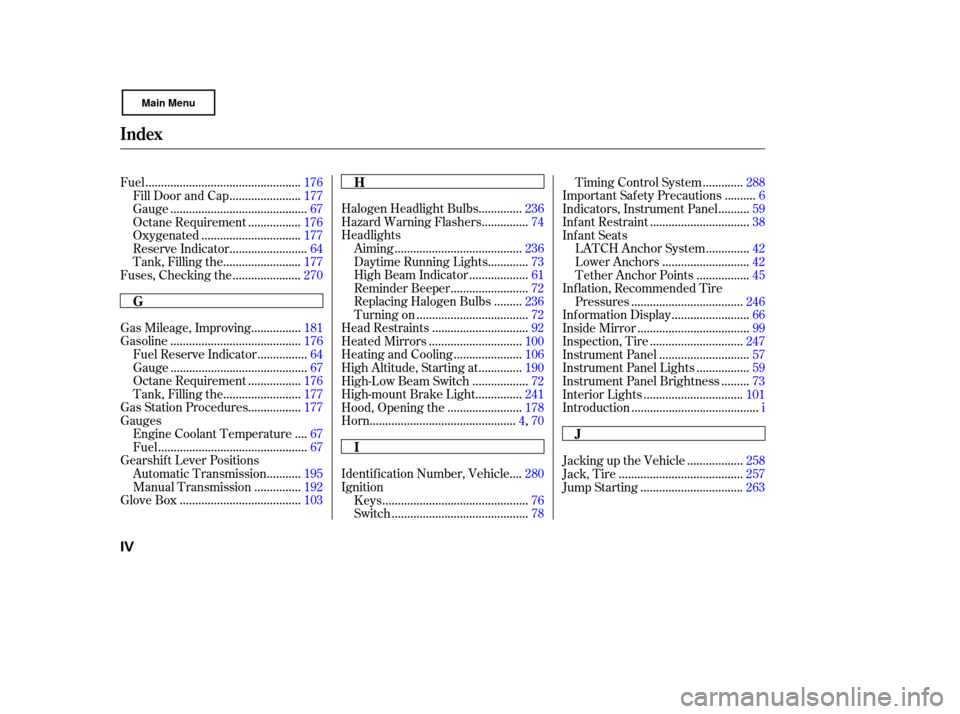
...............
Gas Mileage, Improving .181
.........................................
Gasoline .176
...............
Fuel Reserve Indicator .64
...........................................
Gauge .67
................
Octane Requirement .176
........................
Tank, Filling the .177
................
Gas Station Procedures .177
Gauges
...
Engine Coolant Temperature .67
...............................................
Fuel .67
Gearshif t Lever Positions ..........
Automatic Transmission .195
..............
Manual Transmission .192
......................................
Glove Box .103 .............
Halogen Headlight Bulbs . 236
..............
Hazard Warning Flashers . 74
Headlights ........................................
Aiming .236
............
Daytime Running Lights . 73
..................
High Beam Indicator . 61
........................
Reminder Beeper .72
........
Replacing Halogen Bulbs . 236
...................................
Turning on .72
..............................
Head Restraints .92
.............................
Heated Mirrors .100
.....................
Heating and Cooling .106
.............
High Altitude, Starting at . 190
.................
High-Low Beam Switch . 72
..............
High-mount Brake Light . 241
.......................
Hood, Opening the .178
..............................................
Horn .4,70
...
Identif ication Number, Vehicle . 280
Ignition ..............................................
Keys .76
...........................................
Switch .78 ............
Timing Control System . 288
.........
Important Safety Precautions . 6
.........
Indicators, Instrument Panel . 59
...............................
Inf ant Restraint .38
Inf ant Seats .............
LATCH Anchor System . 42
...........................
Lower Anchors .42
................
Tether Anchor Points . 45
Inf lation, Recommended Tire ...................................
Pressures .246
........................
Inf ormation Display .66
...................................
Inside Mirror .99
.............................
Inspection, Tire .247
............................
Instrument Panel .57
................
Instrument Panel Lights . 59
........
Instrument Panel Brightness . 73
...............................
Interior Lights .101
........................................
Introduction .i
.................................................
Fuel .176
......................
Fill Door and Cap .177
...........................................
Gauge .67
................
Octane Requirement . 176
...............................
Oxygenated .177
........................
Reserve Indicator .64
........................
Tank, Filling the .177
.....................
Fuses, Checking the .270
.................
Jacking up the Vehicle . 258
.......................................
Jack, Tire .257
................................
Jump Starting .263
Index
H
I
G
J
IV